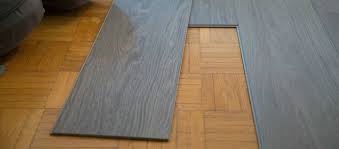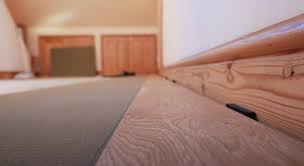Everything you need to know about laminate underlays
Underlay is a vital part of any type of flooring, especially for laminate due to its composition. Choosing suitable underlay for your flooring project is important to make sure that your laminate will last for years to come.
What is a laminate underlay?
Laminate underlay is basically a thin, flexible sheet of resilient material that is installed on top of a subfloor in order to act as a base for the laminate. It is commonly made from thin polyethylene or polypropylene.
Underlay or underlayment is used to help protect your laminate boards by absorbing the moisture coming from the subfloor below. It also helps in minimizing footstep noises as it adds to the thickness of the laminate boards boosting their sound-absorbing qualities, plus it provides additional thermal insulation for your floor to help make your laminate more comfortable underfoot.
Do I need underlay for laminate flooring?
Yes, you will need underlayment for your laminate flooring to help protect your new laminate flooring from the damage that moisture in the subfloor can cause. The underlay will act as a moisture barrier and it will also make the floor more comfortable. But be sure to check what kind of laminate flooring you are purchasing, as some laminate plans or tiles now come with built-in underlay, saving you from the additional step of installing it separately. Your flooring consultant should be able to tell you if the underlay is part of the laminate or if you will need to install it separately.
Types of underlays available
There are different types of underlays, each with its unique features. With this in mind, it is important to consider some important factors before selecting the most ideal underlay. The type of the subfloor, noise reduction, your budget and your preferred use of the space should be key among the factors to consider.
The main types of underlay are foam, rubber and felt.
- Foam: This type of underlay was originally created as a cheaper version of rubber underlay which is considered the superior option. That being said, the construction of this type of underlay has improved over the years so it is now on par with its competitors. It most often comes in rolls and is relatively easy to install.
- Rubber: Is the most popular type of underlay and is suitable for a wide range of flooring options. It is durable, breathable and ‘springy’ so it feels great when you are walking on it! It can come in either sheets or rolls so you can choose what is easiest for you to use!
- Felt: A smooth and heavy underlayment that is made up of recycled fibres it has better noise reduction due to its density and weight. It is also an excellent insulator and a great floor cushion offering a more comfortable feeling. But it is often more expensive due to rubber and foam options becoming cheaper. Felt used to be the only type available but now it is mainly used in commercial buildings.

Laminate Flooring Underlayment Benefits
Moisture Protection
Why do you need to worry about moisture for your flooring? Laminate flooring is made out of composed resin and fiber board materials with a photographic applique layer under a clear protective layer. If moisture from your subfloor (concrete or wood) get to the fiber board material, your flooring will absorb the moisture and start to bow or warp.
Underlayment with a built-in vapor barrier provides the protection you need from moisture.
Cement Subfloor
Cement is a porous material and can absorb and emit moisture. If your installing laminate flooring aka floating floor can be at risk of absorbing moisture from your cement subfloor. Installing an underlayment with a vapor barrier or 6-mil vapor barrier in addition to underlayment will stop all moisture from getting to your floor.

Wood Subfloor
Moisture really wouldn’t be a concern here unless you are installing it over a crawl space. We recommend to install a vapor retarder below in your crawl space to eliminate moisture problems. Adding a 6-mil vapor barrier on top of the subfloor of a crawl space can block the moisture of your subfloor and cause rot in the long haul. No underlayment can fix the issue in the crawl space.
Soundproofing Your Floors
Noise can come from all directions, pets, crying baby, loud steroes, kids playing…you name it. Underlayment can help absorb vibrations from one’s daily noise and block out the noise from other rooms. Our recycled felt underlayment absorb sounds and keep it from traveling to other rooms. Individuals who installed QuietWalk comments their laminate flooring sound more real like hardwood due to the QuietWalk underlayment installed.
Compression Resistance
Having compression resistant underlayment allows a structural foundation to your floors. Normal to high weight stress-loads allow your floor to naturally flex. Compression resistance also allows to hide minor subfloor imperfections and protect the click lock mechanism to provide a solid foundation.

Insulating Value
Insulating is usually thought of adding to walls, roof, windows and doors. However your flooring can cause heat gain or loss. Flooring underlayment has some type of R-values that help improve your comfort underfoot. Choosing an underlayment that provides a higher R-value towards 0.5-0.6 helps keep you comfortable, lower your energy bills, and you’ll enjoy the space even more.
Clean Indoor Air Quality
We wanted to add clean indoor air quality to the benefits as it is the last and unseen benefits most homeowners think about. As most DIY homeowners installs their underlayment, they might notice a harsh odor. This could most likely be coming from their underlayment. Thinking it might go away overtime and it might, but still can give off-gasses of harmful chemicals. Maybe one of your family members start getting sick more often.
Do You Need Underlay for Laminate Flooring
Do You Need Underlay for Laminate Flooring
The need for an underlay for your flooring can very well influence your decision to buy a laminate floor, especially given the expensive cost of an underlay. An underlay is important for many good reasons. Here are the situations when you will need underlay for your laminate floor.
Your Laminate Floor has no Pre-Attached Underlayment
Many modern laminate floors come with a layer of underlayment attached to them. In such cases, an extra underlayment is not necessary. In fact, adding an underlayment in such cases can adversely impact the stability of the floor.
Your Subfloor is Not Flat and Strong
A subfloor needs to be flat and sound to take your laminate flooring. If the subfloor lacks these features, an underlayment helps cover these flaws and give you a stable laminate floor underfoot.
If you install a laminate floor without underlayment on a weak or uneven subfloor, it can damage the laminate floor and create safety hazards.
You are Using a Concrete Subfloor
Using an underlayment over a concrete subfloor makes the laminate floor soft and comfortable underfoot. The absence of an underlayment in such cases can make your floor a nightmare to walk on.
Your Subfloor is not Vinyl
When installed perfectly, a vinyl subfloor is waterproof. If you are installing your laminate floor on a vinyl floor, an underlayment is not necessary.
You want a Silent Floor
Laminate floor is very thin, given that it is made of fibreboard. Therefore, it cannot absorb sound as efficiently as solid hardwood does. But, an underlayment creates a sort of padding to the floor, which boosts the floor’s sound absorption abilities.
So, whether you are looking to create a quieter ambience at the office or looking to reduce the sound impact of mischievous kids and pets in your home, a laminate floor with an underlayment can work wonders.